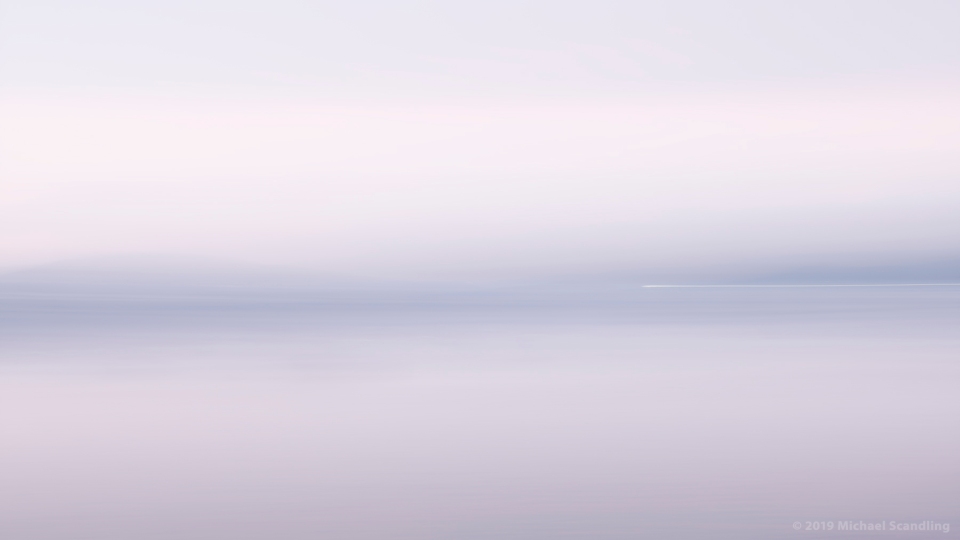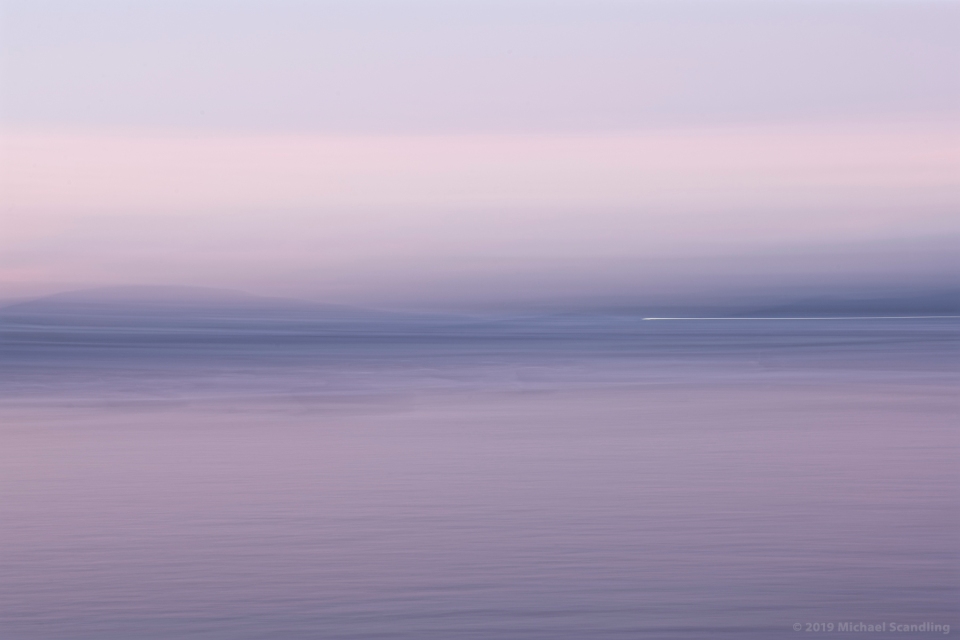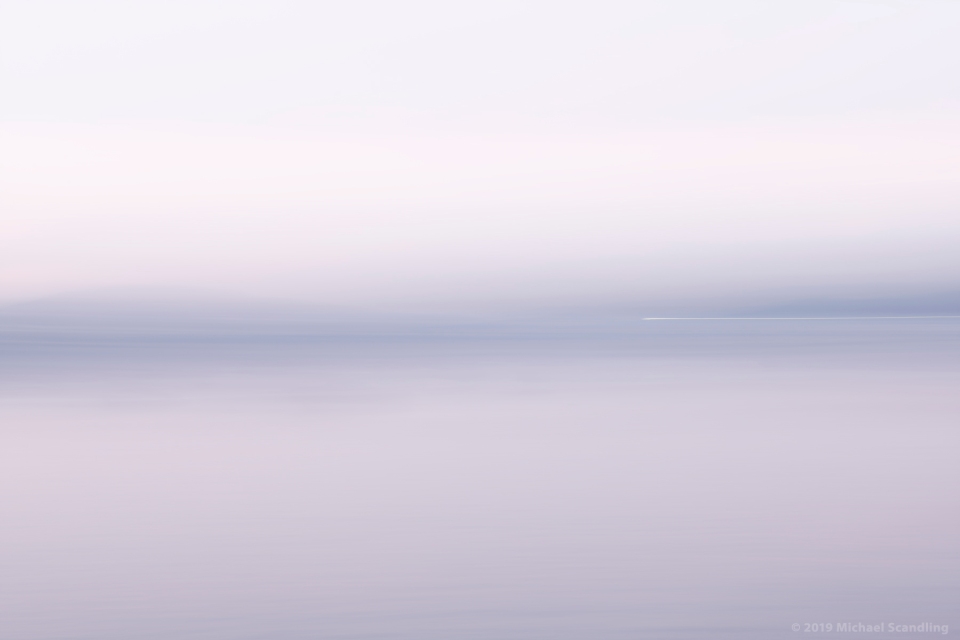
September 7, 2019 — Lake Tahoe. f/16, 4 seconds, ISO 64. Pan to the left.
This is the longest uninterrupted series I’ve done so far on this blog. Your comments have been interesting, informative, and gratifying. A number of people have asked in comments, email, and in person, to see a “before” image.
I don’t usually like to discuss technique because I think it’s potentially limiting: I don’t want it to come off as “do it this way.” So if this interests you, please look at it as “Here’s how I happened to go about it this time. If you try something like this, your process and mileage may vary.” The key thing is, all of this is experimental and if/when I come back to these images for another try, I’ll almost certainly do something different.
Here’s what came out of the camera: 14-bit NEF (Nikon RAW) file. What you see is what I got:

First step was to straighten the horizon — because what good is a horizon shot with an off-kilter horizon?* I also used a healing tool to remove sensor spots because — shame on me — I didn’t clean my sensor before going out to shoot. By the way, all of these steps were done in DxO PhotoLab, up till the very last step which was done in Photoshop. DxO PhotoLab is similar in function to LightRoom. I’ve been using it for years; I’m familiar with it and I like it.
I noticed some interesting texture on the horizon, so I tried bringing it out by increasing Microcontrast. (Microcontrast is similar in function to Clarity in LightRoom and Adobe Camera Raw.) It brought out the texture just fine. It also shouted out some already visible artifacts of boats that were anchored in the water and I don’t want no stinkin’ boats in my image! You’ll see them as darker streaks if you look at the middle of the image, left of center:

At this point I realized that this would be a good companion piece — at least in concept — to the image in my last post,** and that bringing the Microcontrast down would soften the overall image and blur the boats out.
Still in keeping with the last post’s image, I brought the exposure up 1.3 stops to make it delicately high-key. At the same time, I reduced both vibrancy and saturation by 20% each to be left with just a hint of color. I also applied very subtle graduated filters to the top and bottom and slightly reduced the exposure of each to better frame the horizon itself. As a last step I over-sharpened the overall image (unsharp mask) to emphasize the light streak and to recover just a little bit of texture for interest:

Finally I exported the image from DxO as a 16-bit tiff and brought it into Photoshop to give it a 16×9 crop, reduce the image size for the blog, and output it as 8-bit sRGB jpg. And Bob’s your uncle:

(Nikon D850, Tamron SP 24–70mm f/2.8 Di VC USD G2. RAW processing in DxO PhotoLab 2.3; Final editing in Adobe Photoshop.)
For more abstracts, go to www.amagaphoto.com.
* In many of these images, the horizon is ambiguous. What exactly is the horizon? In this case I used the light streak as a guide.
** They were exposed only a minute apart.
I’d be satisfied with the second image, the one with a straightened horizon and increased microcontrast.
LikeLiked by 3 people
Thank you. And on another day I might have as well.
LikeLike
I agree, it’s beautiful!
LikeLiked by 1 person
Thank you. There are many ways to look at the same image.
LikeLike
Skillfully and tastefully executed.
LikeLiked by 1 person
Thank you very much.
LikeLike
Thanks for the process review Michael, very interesting. Have you done any very large framed printed from the series?
LikeLiked by 1 person
Thank you very much. Not yet. I’m waiting for a favorite to rise to the top.
LikeLiked by 1 person
If you had a single favorite from this series, which would you choose, and why?
LikeLike
My fav is Embraceable Lights, because of the depth of color and the movement within it
LikeLiked by 2 people
Thank you very much. Glad you took the time to take a look.
LikeLiked by 1 person
I can’t speak for the rest of your followers but I’m fascinated with the how-to when it’s included in the post. I’d like to point out that you don’t get an image this nice unless you start with something really nice, no matter ho many processing steps are involved. Nice work, Michael.
LikeLiked by 2 people
Thank you very much. One of Bruce Percy’s blogs starts with a question to a recording engineer: “How do you get a good guitar sound?” Answer: “Start with a good-sounding guitar.”
LikeLiked by 1 person
Spot on! 🙂
LikeLike
Serenely beautiful, Michael. Honestly, after the horizon straighten, the image straight out of the camera is terrific.
LikeLiked by 2 people
Thank you. It’s not bad at all in its own right and with the exception of the ghost boats, I could take it. And I might just do that in some future time. That’s part of the beauty of shots like this. There are infinite interpretations.
LikeLiked by 1 person
Great posts on this subject, thank you for sharing the photos and technique! Sometimes I come across a scene like this, subtle but something is there, and usually get a muddied mess that doesn’t convey the beauty seen while taking the photo. It is hard to translate delicate tones such as these into a thoughtful piece, so bravo and thanks for sharing as always!
LikeLiked by 2 people
Thank you. Part of the message here is that there is often treaure in images, but it must be found and exppressed. In this case, I knew in advance that these shots were mostly giong to be starting points for further work in post — but a couple were almost perfect straight out of the camera.
LikeLiked by 1 person
Intriguing shots and process, Michael. I guess I’m most drawn to #3 (this goes against most of your comments), but I like the hint of the boats and the lighter spots in the water and the more defined graduation of color. I love this series, which shows the beauty of subtlety and hues.
LikeLiked by 1 person
Thank you very much, and this is a big part of what informs me: different people see different things and have different likes. I already know that I can get quite a number of different finished images out of one original shot. This tells me that maybe I ought to. We’ll see. One thing is absolutely certain: I will not put out an image that I myself don’t like. In the silver horizons gallery of my formal website you will see two different renditions of exactly the same exposure. I love them both, but for different reasons.
LikeLiked by 2 people
I will take a look, Michael. This is a fascinating process.
LikeLiked by 1 person
Thank you very much. It is definitely a fascinating process. It opens my eyes every single time.
LikeLiked by 1 person
Out of the camera works well and several of your adjustments could stand on their own too. But it’s about vision and that makes the final the winner. It is what you visualized as you started the process.
Seeing how other people accomplish their trade, whether photography or some other pursuit, is instructive. That’s why we study Adams, Porter, Weston, as well as contemporaries,etc. I am sure you have others I don’t know of more in keeping with how you perceive your images. There’s always some nugget that all of a sudden seems appropriate to our own workflow and helps expand our vision.
LikeLiked by 2 people
Thank you very much. And you have said it. Essentially, I’ve been thinking kind of high-key recently. Most of these abstracts are more in that realm. You’ve seen enough of my stuff to know that much of what I do happens in post. But I usually do have a vision when I press the shutter button. What is unique about these ICM’s is that each exposure that comes out of the camera is essentially a blank canvas. It’s a starting point. And was always meant to be. So then it becomes a matter of “what can I discover in this exposure that I had no idea was there?” Take a look at the Portuguese horizon that I posted sometime in September. What came out of the camera was a bland banal image. Weather-wise, the sky really had nothing to offer. If anything at all was going to happen, it was going to happen in post. And I knew that when I originally pressed the shutter button.
LikeLiked by 1 person
While my work is more in the realm of realism, I do take liberties with personal expression. The human is what is conveyed by our images. Getting it right in the camera is nice, and it does take skill, but giving your own spin to things through processing is where personal expression comes in. I think much of what we do in post is not all that far removed from the wet darkrooms of old, some do still go that route, and even compositing was done in the past. So post is a great place to let your inner feelings about a scene come out, even some feelings you didn’t know were there at the start. 🙂
On a related but side note, when have you ever heard someone question a painted work of art as “did it really look that way?” Just because a camera is able to capture a scene close to reality does not mean our expression has to mirror that. I don’t think copying a full moon, enlarging it, and having it rise over some unlikely spot is good photography, but using our tools in a way to give a different view of a subject is art. So discover away, Michael. 😉
LikeLiked by 1 person
And you too, my friend.
LikeLiked by 1 person
My wisecrack answer to “did it really look that way” is “of course it did.” A more serious answer would be that it did look that way in my imagination. Then it was a question of manifesting it in pixels. We do exactly what was done in a wet darkroom, but it (sometimes) takes us less time and we don’t have to breathe those noxious fumes. Photography is writing with light and as writers we can write fact or fiction, documentary or fantasy.
LikeLike
Yup.
LikeLiked by 1 person
Excellent images.
I like the ones with the pale colours best. I think this makes the pictures more lush and mysterious.
LikeLiked by 1 person
Thank you. I tend to want to create images that draw the viewer in to complete the picture.
LikeLike
I can see that. And for me it works more with the pale colours. At least in this series. And somewhat the colours seem to have more shades that way.
LikeLiked by 1 person
Thank you very much it is true that as the saying goes paler the subtlety of the colors is enhanced.
LikeLiked by 1 person
And you have just proven that it is true. 🙂
LikeLiked by 1 person
Thank you very much.
LikeLiked by 1 person
Thank you for sharing the process, Michael. The result is amazing!
I’m not familiar with the DxO PhotoLab .
LikeLiked by 1 person
DxO PhotoLab is amazing software for developing raw files. Among many other things, it has the cleanest noise reduction I have ever seen.
LikeLiked by 1 person
Thank you, Michael!
LikeLiked by 1 person
I enjoyed this, Michael – it’s generous of you. The caveat that we each should find our own way is well taken, but how interesting it is to see the step by step process as it evolved this time.
LikeLiked by 1 person
Thank you very much. Yeah I don’t want to stifle anybody else’s creativity. But it is interesting to show the evolution of an image. Of course, next time it could be completely different.
LikeLiked by 1 person
These are really just so peaceful and beautiful. I would have been happy with the image as it came off the camera but going back and forth, I see how much nicer it is with you tweaks.
LikeLiked by 1 person
Thank you very much. That’s how I saw at that time. Another time I could very well see it different.
LikeLiked by 1 person
Thank you for sharing your approach and workflow, Michael. The high key element and pale colours enhances the image. This is beyond beautiful.
LikeLiked by 1 person
Thank you very much, Dina. You made my day. I want to say again that I love your white swans against black. These photographs of the essence of elegance.
LikeLiked by 1 person
I hope you enjoy the other abstracts in the series.
LikeLiked by 1 person
Dear Michael,
we really like your abstract minimalistic pictures. We actually like most your last picture here. For us it’s the most subtle one.
Wishing you a great week
The Fab Four of Cley
🙂 🙂 🙂 🙂
LikeLiked by 1 person
Thank you very much. I much appreciate this. All the best to you, Fab Four.
LikeLiked by 1 person
I’m take another visit here. It take artistic eye and a lot patience to get it done right. The result you are showing us is remarkable. I also like the image of “What you see is what I got”.
LikeLiked by 1 person
Thank you very much. The true message is there is no such thing as an absolutely right answer in an individual‘s artistic expression. One does what one does.
LikeLiked by 1 person